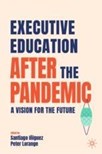- Learning
Executive Education Post-Pandemic
A positive assessment of the changing face of corporate and executive learning provision post-pandemic and beyond
To ensure business leadership is up to the task, business education and executive development need to play an essential role.
Since the first business schools opened in the early 20th Century, the corporate environment in which they operate has changed enormously. Today market disruption and new demands on business—for sustainability, inclusion and diversity, integration of AI, etc.—have greatly accelerated this change. Arguably the business education sector has not kept pace with the rate of change.

Then along came the COVID-19 crisis. A global health crisis that for business schools was also an existential crisis of collapsing revenues. Or was it perhaps an opportunity?
In their new book, Executive Education After the Pandemic, Santiago Iñiguez de Onzoño, Dean of IE Business School, and Peter Lorange, former President of IMD, are firmly on the side of opportunity. An opportunity and a catalyst for innovation and faster change.
Although sub-titled A Vision for the Future, the book does not offer a set prescription. Rather it presents invaluable insights, based on experience and real cases, from sector-leading executive educators and thought leaders, in the form of 32 individual essays, introduced and clearly summarized by the two authors.
The book provides a guide for business schools, executive education centres and their corporate clients as they seek to grasp the opportunity for change presented by the pandemic. A pandemic that has brought intense focus on the need for business leaders to adapt, innovate, show entrepreneurial initiative, set a trajectory for the future, formulate a vision, while at the same time inspiring team commitment and motivation—all the attributes of good leadership but turbo-charged by extreme uncertainty.
Structured in three parts the book opens by considering the purpose of executive education provision, focusing on the macro trends evolving in post-pandemic business and society, and on the need to develop leaders ready to build a sustainable equitable world. Amongst the seven essays in this section Santiago Iñiguez proposes associating management teaching and research with the ‘humanities’—with their focus on overarching human values dating back to antiquity and their emphasis on social coexistence and civic behavior, much needed today—as opposed to the traditional ties to the ‘social sciences’. In this section Nick Van Dam, a professor at IE, Nyenrode, and Pennsylvania Universities, considers seven primary trends that are altering the way workplaces look and operate, how the future of work will change the dynamics of team leadership, and how executive education should react..
The second part of the book, titled The Renaissance of Business Schools, looks at areas of business school activity that are ripe for rethinking post-pandemic. Included in this section is a stimulating chapter, from Wharton’s Professor Jerry Wind, which champions experimentation and a pivot to lifelong learning, suggesting these ten areas for transformation:
- Expand the target audience and consider changing the name
- Design for lifelong learning
- Challenge the unit of learning
- Reimagine the objectives and content
- Employ innovative pedagogical approaches
- Don’t take the schedule for granted
- Create and orchestrate a community of learners
- Leverage the technology
- Design the needed integration with the future of work initiatives and the offering of innovative agile and diverse programs and experiences
- Develop new business and revenue models.
The final part focuses on the advances in technology that have the potential to revolutionize executive education, and how these are best combined with traditional pedagogy and academic values to create educational models that deliver positive impact for individual learners and client organization. A standout chapter in this section, from IMD President Jean-François Manzoni, looks at the role of Technology-Mediated Interactions (TMIs)—interactions between faculty and learners that occur ‘virtually’ rather than face-to-face. Manzoni highlights how lessons learned at IMD under duress during the pandemic have proved the value of TMIs, not just as a substitute for in-person learning, but as a way to improve learning experiences and outcomes, and enhance blended learning offerings.
Santiago Iñiguez de Onzoño and Peter Lorange have selected a broad range of topnotch contributors and revealing case studies to anticipate future trends and share in-depth knowledge of what it will take to build executive educational provision fit for a rapidly changing future world. Overall, the conclusions reached are positive and important reading for anyone involved in executive development.
………………………………………………………………………………………………………………….......
ARTICLES YOU MIGHT LIKE
VIEWPOINT
For Thomas Misslin, transformation rather than training is the aim of executive education at emlyon business school
DEVELOPING LEADERS QUARTERLY MAGAZINE AND WEEKLY BRIEFING EMAILS

































